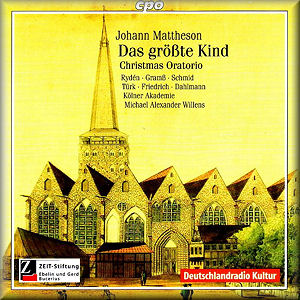 |
 |
|


alternatively
CD:
AmazonUK
AmazonUS
MDT
Sound Samples and Downloads
|
Johann MATTHESON (1681-1764)
Das größte Kind - Christmas Oratorio in 2 parts
 Susanne Rydén, Nele Gramß (soprano), Anne Schmid, Melissa Hegney (contralto), Gerd Türk, Ulrich Cordes (tenor), Wolf Matthias Friedrich, Thilo Dahlmann (bass)
Susanne Rydén, Nele Gramß (soprano), Anne Schmid, Melissa Hegney (contralto), Gerd Türk, Ulrich Cordes (tenor), Wolf Matthias Friedrich, Thilo Dahlmann (bass)
Kölner Akademie/Michael Alexander Willens
rec. 20 December 2008, Peterskirche in Kempen, Germany. DDD
 CPO 777 455-2 [56:01]
CPO 777 455-2 [56:01] 
|
|
|
Johann Mattheson was not only a prolific writer of books about
music, he was also active as a composer of mainly vocal music.
He wrote a number of operas and oratorios, the latter in his
capacity as cantor of Hamburg Cathedral. Because of the special
status of the cathedral - it was not under the supervision of
the city council - Mattheson had freedom to perform the music
he wanted. He could also choose the interpreters he preferred,
among them singers who worked for the Hamburg opera. They had
the technical skills to sing the vocal parts in his oratorios
which were sometimes quite demanding. That is also the case
in the oratorio Das größte Kind.
This 'Christmas Oratorio' has nothing in common with the famous
oratorio of Johann Sebastian Bach. Not a single verse from the
gospels is quoted here. The unknown librettist uses a free poetic
text, which is extended by stanzas from two well-known hymns:
In dulci jubilo and Gelobet seist du, Jesu Christ.
There are some biblical characters, like Joseph and Mary and
shepherds, as well as allegorical figures: the Bride of Christ,
Devotion, Meditation and the Children of Man - but no Evangelist.
The story is set in Bethlehem, with - in part one - Joseph and
Mary singing God's praise in the stable. The second part concentrates
on the shepherds telling them that the angel has announced the
birth of Jesus.
Among the technically demanding parts in this work is the aria
'Was schad't mir der Tod' (How can death harm me) for soprano
(the Bride of Christ), transverse flute and basso continuo.
It has a very high range which is only just within the tessitura
of Nele Gramß. She sings it very well, though, and Annie Laflamme
delivers an exquisite performance of the flute part. The longest
aria is that of Mary at the very end of the oratorio, 'Komme
dann, erwehlte Seele' (Come then, chosen soul), which is sung
by Susanne Rydén. She does quite well, but I am really surprised
by her singing in this recording. I have heard her many times
on disc, and was always struck by the clarity and purity of
her voice. In one of her recordings she sings with Emma Kirkby,
and their voices blend superbly. Here her singing is marred
by a big wobble, in particular on unstressed notes, which seems
to me a technical deficiency. It is to be hoped that this is
temporary, because it isn't pleasing to listen to. And as she
has an important role in this oratorio it undermines the overall
quality of the listening experience.
Wolf Matthias Friedrich in his role as Joseph sings his aria
'Heller Glanz von 's Vaters Licht' (Radiant glow of the Father's
light) beautifully, but he is disappointing in the recitatives
which are artificial and rhythmically too strict – as with all
the recitatives in this recording. Thilo Dahlmann is new to
me, and I am pleased by his performance of the aria of Meditation,
'O allerliebstes Kind' (O child dearest of all). In the duet
of the Children of Man, 'Wer kann dieses recht erwegen', the
balance between Nele Gramß and Anne Schmid is less than ideal.
Delightful is the trio of Shepherdesses and a Shepherd, 'Es
klopft noch unsre volle Brust' (Our hearts even now do throb),
in which the throbbing is imitated in staccato figures in the
orchestra as well as in the vocal parts.
This trio is just one example of the imaginative and evocative
way Mattheson sets the text to music. His treatment of the chorales
is also interesting. There are no simple harmonisations here.
The two stanzas from Gelobet seist du, Jesu Christ which
end the first part and open the second - musically the second
is a repetition of the first - are dramatised, so to speak,
in that fragments of the hymn are repeated or dramatic pauses
are included. In the second part three stanzas from In dulci
jubilo are used, and after every line the two horns repeat
the last notes of the choir, as an echo.
In this performance the 'choir' consists of the soloists with
some additional singers to a total of eight voices. It is involved
in several 'arias with choir'. This mostly means that at some
moment the choir intervenes and repeats one line from the aria.
But in the aria of Devotion, 'Großer Gott' (Great God), the
soloist (Gerd Türk) sings a line which is then immediately repeated
by the choir. Lastly it should be said that several arias seem
to reflect that Mattheson considered an oratorio as an opera
with a sacred subject. Some are quite operatic, especially in
the use of long and virtuosic coloratura passages. The opening
chorus also has that element.
Last year Michael Alexander Willens conducted another oratorio
by Mattheson, Der liebreiche und geduldige David, also on CPO.
I wasn't that impressed by its quality. In my opinion this 'Christmas
Oratorio' is much better, even if one has to readjust, being
acquainted with Bach's completely different Christmas Oratorio.
It is well worth it despite the performance having some serious
shortcomings.
Johan van Veen
|
|

